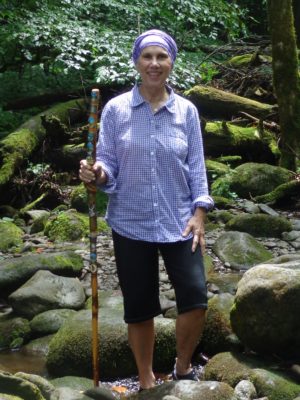 My Amyloidosis & Myeloma Journey
My Amyloidosis & Myeloma Journey
Kathleen Reid
I have always been the kind of person who follows the rules. I was always healthy, ate well, exercised, and had a lot of energy. So when I was diagnosed with amyloidosis and myeloma, people asked, “How can this happen to you when you have done everything right?” I admit that I thought the same thing but as I learned more about this disease, I realized that while my healthy habits did not prevent me from getting amyloid, they certainly helped me survive this roller coaster journey.
As far back as 2011, I noticed becoming more fatigued when I exercised. Then, in 2012, I began having irregular heartbeats and shortness of breath with nothing more than walking fast or climbing a couple flights of stairs. I went to a cardiologist who had previously performed a cardiac ablation to correct my rapid heartbeat 12 years earlier. He found my heart slightly enlarged but said it was probably due to my strenuous exercise regimen. He advised that, at 67 years of age, I should probably slow down.
In the fall of 2012, I went to Santa Fe for three months with my husband for his job. The high altitude, 7000 feet, exacerbated my problem but also may have saved my life. I tried to hike but couldn’t walk more than a short distance before I had to stop and rest. I had a problem climbing one flight of stairs and exercise was out of the question.
We had decided the altitude was more than I could take so the beginning of December, I decided to leave and drive home. My husband was not quite finished with his job so I drove his truck home by myself. I drove two 12 hour days to get home as fast as I could. I had imagined getting better as I got to a lower altitude. That didn’t work and the day after I got home, I wound up in the local emergency room where I was diagnosed with severe congestive heart failure due to prolonged altitude sickness. I had an ultrasound and the next day I saw a young cardiologist that had studied at the University of Michigan under the same doctor that had done my ablation almost 15 years earlier. He suggested I go to Vanderbilt to see a thoracic surgeon about the possibility of a valve replacement. He noted on my ultrasound, “possible infiltrative disease.”
I called every day checking on possible cancellations and was extremely fortunate to get into the Vanderbilt University Medical Center thoracic surgeon on December 23 due to a cancellation. He looked at the previous tests and thought it was something as “simple” as a valve replacement, but he needed another test. That test proved negative as did a couple more over the next few weeks. I did not need a valve replacement so he turned me over to another cardiologist.
I met with the new cardiologist and noted that I was concerned about several years of slightly elevated protein on my previous blood test. Nine years to be exact. He scheduled me for a catheterization to check for arterial disease and also ordered a blood test. The hematologist examined the blood results as well as a bone marrow test, and called me saying he wanted another test to confirm/clarify an indication on the first blood sample. The second blood test came back positive for myeloma on Monday, March 4. My catheterization was the next day. Based on all the problems I was having with my heart, he called the cardiologist and asked him to get a biopsy while he was in my heart. I had the procedure the next day. On Friday of the same week the cardiologist called me and told me my arteries were good but they had confirmed amyloid in my heart.
That weekend was spent researching, crying, and trying to get our heads around this horrible diagnosis. We made appointments with oncology to get a treatment regimen. My new amyloid cardiologist told me my heart was too bad to withstand the rigors of stem cell transplant so, for the time being, my only choice was chemotherapy. Another hematologist said I was probably too old for stem cell transplant. That was all I needed to hear to mentally set me on a path to stem cell.

For the next year my only goal was to maintain a positive attitude and do everything I could to improve my health enough to be able to get a stem cell transplant. Finally on February 28, 2014 I received an autologous stem cell transplant. I was in the hospital over a month in preparation and recovery, and of course three months confined to home after.
The stem cell transplant didn’t do everything we had hoped for. I never went into remission although my blood numbers improved considerably for the next few months. I’ve been on six different combinations/variations of chemotherapy. Most have worked for a time before my numbers begin to rise again. I am anxiously waiting for new drugs dedicated to controlling the amyloid because I feel that is my main concern. I pray that they will be quickly approved and released for patients.
Today, I am much better than I was when I was diagnosed. My Vanderbilt Amyloid Multidisciplinary Program (VAMP) doctors, oncologist Stacey Goodman and cardiologist Daniel Lenihan, continually work to balance my treatment to give me a good quality of life.
I can’t control this disease but I can control myself. First and foremost, I have faith in the Lord, and beyond that, I have a positive attitude, exercise, do yoga, eat healthy, and keep others in my prayers. I am continually grateful for the support of my family and friends, the Vanderbilt University Medical Team, and especially my loving caretaker and husband, Tony.
Update: August, 2019
In January 2018, my heart began to fail. My cardiologist told me that I was in “end stage” heart failure and my only option was a heart transplant. I was put on the list and sent home with an IV pump. In April, I was admitted to the hospital and told that I would not leave without a new heart. The cardiologist came in and said that they had an “at risk” heart if I wanted it. I was told it was a Hepatitis C diseased heart but that the Hepatitis C could be cured. At 74, I became the oldest recipient to receive a heart transplant at Vanderbilt on April, 28, 2018.
I still have myeloma and AL amyloidosis in my gastrointestinal tract and my kidneys. But God, Vanderbilt and my donor gave me a new heart. I’ll soon begin my eighth different chemotherapy session since my diagnosis but, at age 75, I’ve returned to exercise and other activities. I will continue to try to stay positive and fight this sinister disease.
-Kathleen Reid
